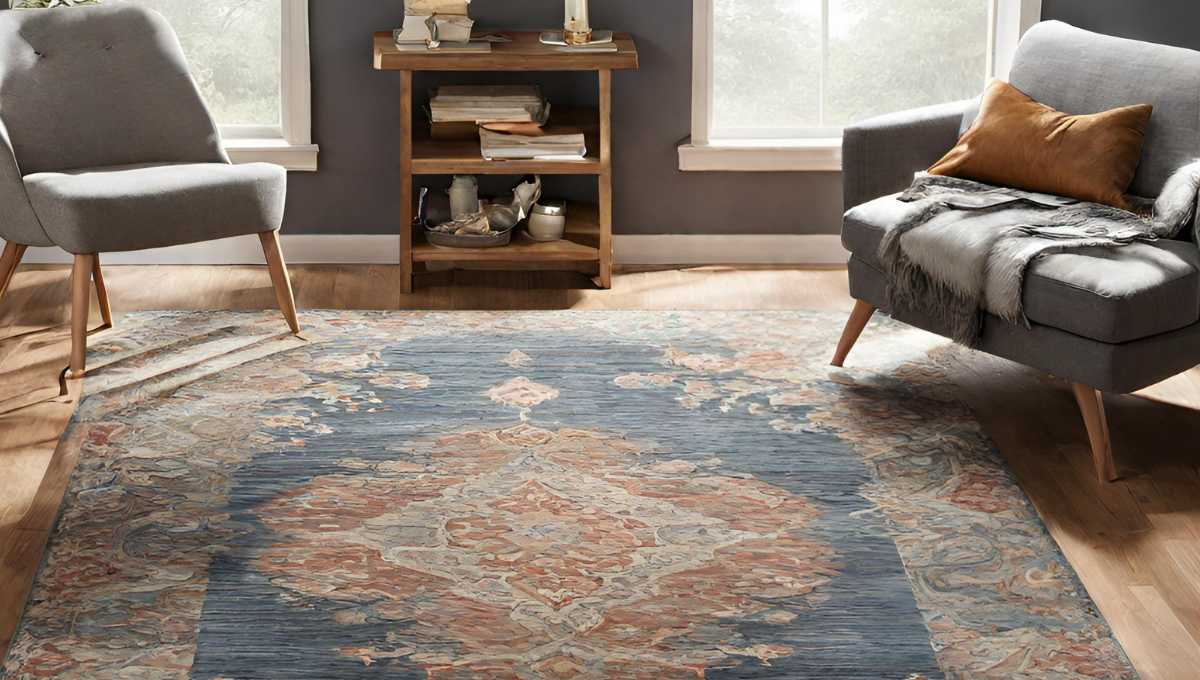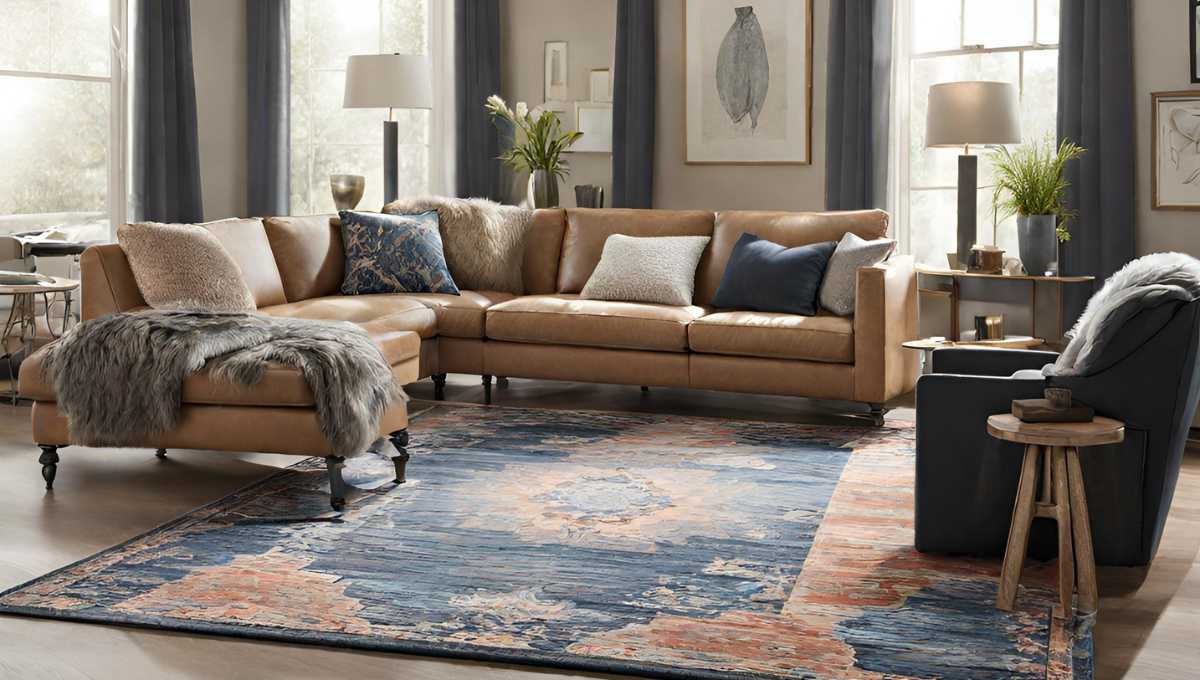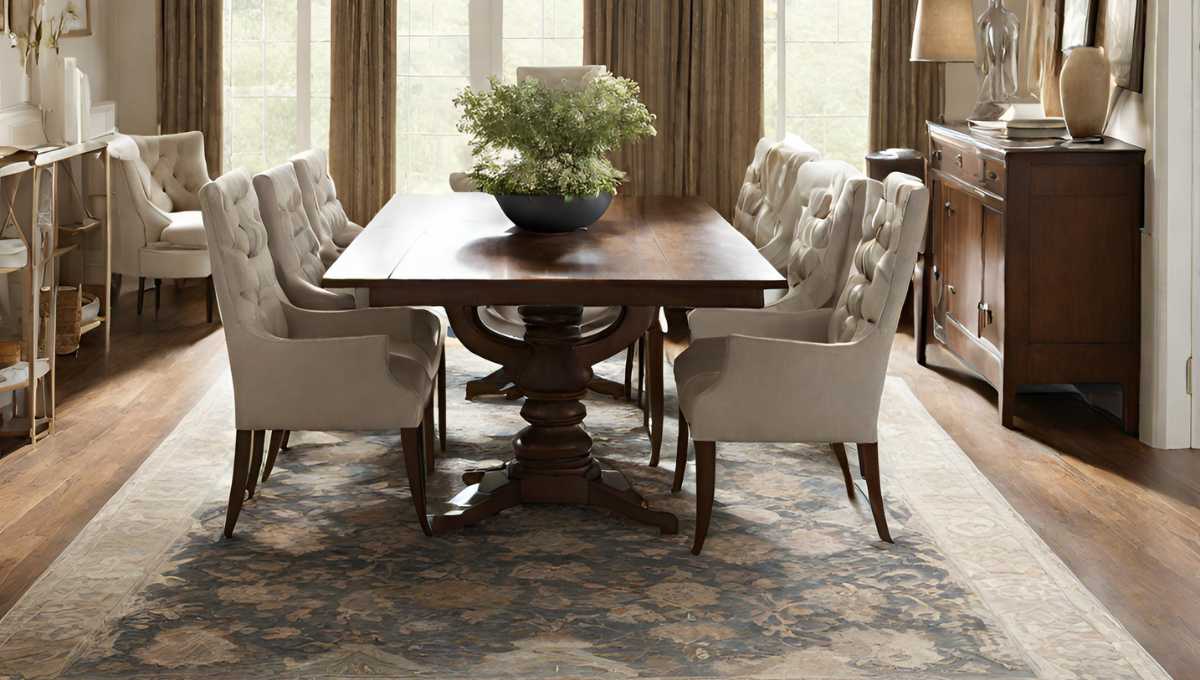
common mistake of area rugs
Area rugs are the most important things in home decoration. Here are some tips that indicate the common mistake of using area rugs. Let’s talk about it.
Let’s talk about the number one most common mistake I see made:
too small of an area rug.
In This Post
ToggleI see this mistake most commonly made in three areas in area rugs of your home:
- the living room
- the dining room
- and the bedroom.
Let’s talk about that too-small area rugs for your living room.

The area rug should fit all of the furniture on top of it, with at least a six-inch border around the furniture. If you can’t get those six inches, at least the front legs of the furniture should sit on top of the rug. Remember that the area rug should define the area and the seating group. Too small, and it will make your large, expansive space look even smaller than it is. What we’re trying to do is expand the visual footprint of your living room.
Moving on to the dining rooms area rugs

The dining room’s area rug should be large enough so that when you scoot your chair out, you will still be on the rug. This helps protect the flooring underneath it, and of course, it’s just more ergonomic for you to be scooting on top of a rug instead of halfway on the rug and halfway on the flooring beneath it. If you want to get really technical here, measure 36 inches away from the perimeter of your dining table. That is the minimum size your area rug should be. If you can’t find an area rug large enough for that size or if you can’t afford that size, consider not buying one at all and leaving the table floating on the floor. This method will also make the space seem larger if you don’t have any area rugs to break up the flooring.
Let’s talk about bedrooms area rugs.

For a queen bed, the minimum would be an eight by ten. For a king or cow king bed, the minimum size of the rug should be nine by twelve. You want the bed to sit comfortably on the rug and have a runner-type spacing on both sides of your bed in front of your nightstands. The idea here is to have your feet softly land on the rug and not on the hard flooring underneath it. If your feet land on the flooring, you want to pull the area rug up towards the nightstands.
Remember my cardinal rule when it comes to area rugs?
Buy the largest rug that you can afford. This will give you some flexibility down the line when you move from home to home. Let’s say you purchase the largest area rug for your bedroom, but you want to use that for your dining room in the future. Buying the largest area rug will allow you to move it from space to space.
Another common design mistake I see is suffocating the room with an area rug.
that butts right up against the walls. You don’t want to suffocate the rooms with an area rug that goes wall-to-wall. It almost feels like carpet, and you can’t see the beautiful flooring underneath it. Give the rugs and your spaces some breathing room. Start at least six inches away from the walls, and try not to exceed 12 to 18 inches unless you have a huge space to begin with in the first place. Then, 12 to 18 inches is a variable. If you’re looking for an area rug to fill the space, position the rug so it’s about 12 inches away from the wall to the border of the rug, which means you want approximately 12 inches of floor surface peeking through, give or take. Mess around with the sizes and configurations and see what you like best.
Another common design mistake I see is buying the wrong type of rug for the area or your lifestyle.
Let’s break down the most popular rug types by material and fiber.
Wool rugs
Wool rugs are extremely durable, luxurious, and allergy-friendly, but they are known to retain moisture that can cause mildew. So, you wouldn’t want to use them for wet areas like bathrooms, laundry rooms, or even mudrooms. Wool requires professional cleaning but looks brand new once you get it cleaned. So wool is definitely an investment that you’ll make that you’ll have for decades down the line.
Moving on to natural materials like jute, sisal, or seagrass
the chunky fibers, the organic look. But they shed a lot, especially in high-traffic areas. If you have kids and pets running around, be prepared to constantly vacuum.
Silk rugs
Silk rugs are strong, but not as strong as wool. The tensile properties of silk make it ideal for weaving intricate designs. Silk rugs are super expensive, very exquisite, and finely made, which means they’re typically displayed on walls rather than used on floors. However, with that being said, silk is still susceptible to moisture damage, moth larvae, and color runs. So be sure to use it in a low-traffic area and avoid placing it in direct sunlight or high-moisture areas.
Polyester, polypropylene, and nylon rugs
Polyester, polypropylene, and nylon rugs are synthetic materials that are great for high-traffic areas, playrooms, mudrooms, and even bathrooms. They’re very durable, easy to clean, and not as expensive as natural fibers. They’re also stain-resistant and fade-resistant, making them ideal for areas with direct sunlight.
Let’s talk about the last common design mistake I see made:
not using a rug pad underneath your area rug. This is a big no-no. You should always use a rug pad underneath your area rug, no matter what size, shape, or material it is. Rugs are slippery, especially if you have hardwood or tile flooring. Rug pads provide extra grip and prevent the rug from moving around, which will ultimately help prevent trips and falls. Rug pads also protect your flooring from scratching and color transfer from the area rug. They also add an extra layer of cushioning underneath your feet, making it more comfortable to walk on, especially if you have hard flooring underneath it. You can get rug pads at your local hardware store, your local rug store, or even online. They come in all different sizes, shapes, and materials, so you shouldn’t have any trouble finding one that fits your area rug perfectly.
FAQ
Measure the seating area or space you want to cover and choose a rug size that allows for at least a few inches of floor space around the edges.
Durable materials like wool or synthetic blends are ideal for areas with heavy foot traffic, as they are resistant to wear and tear.
Yes, mixing rug styles can add visual interest to a room, but be sure to maintain cohesion by sticking to a consistent color palette or design theme.
It’s best to vacuum your rug at least once a week and spot clean any spills or stains promptly to prevent permanent damage.
Yes, rug padding not only adds comfort underfoot but also helps protect both the rug and the floor beneath it.





